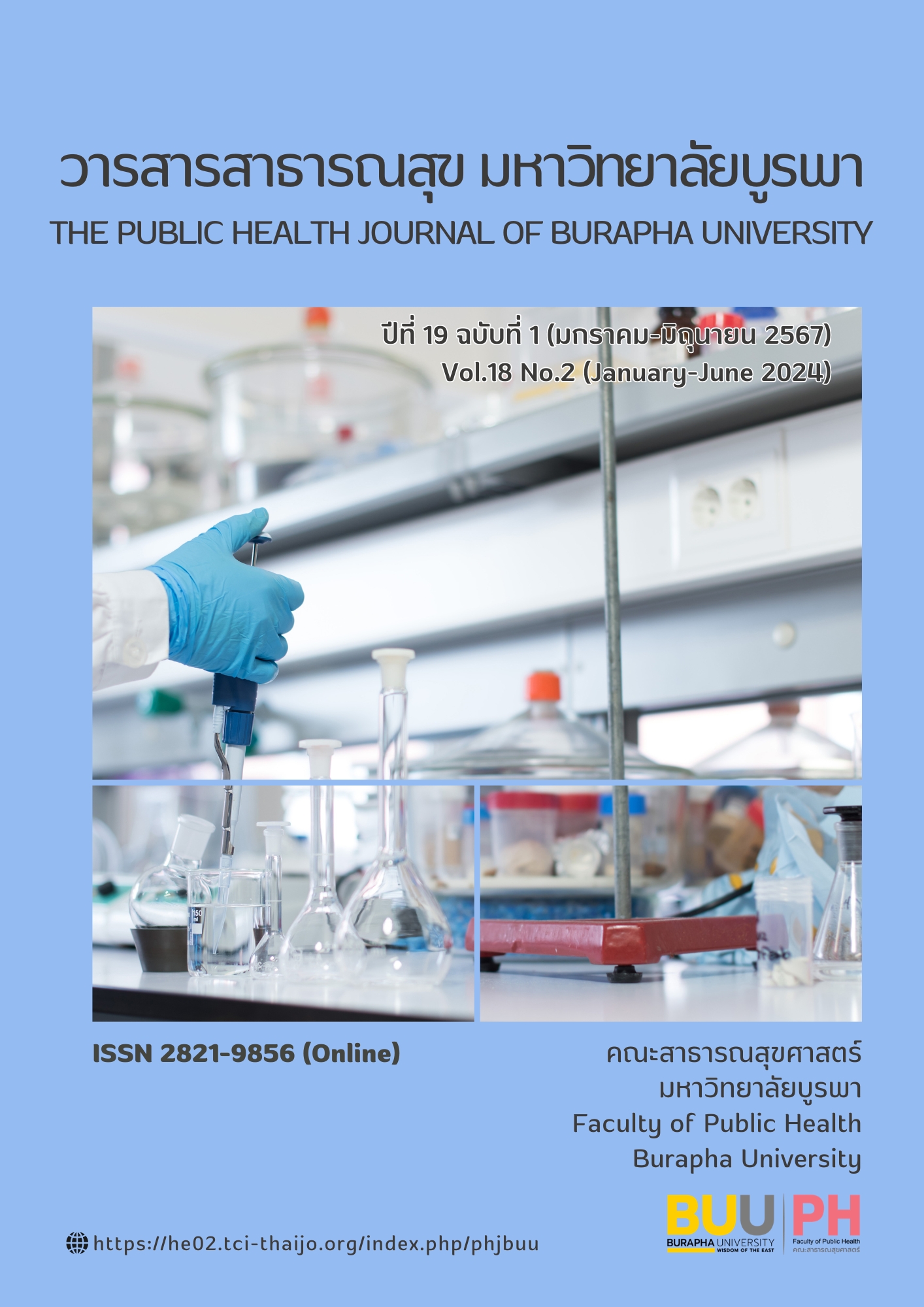ความแตกต่างทางเศรษฐกิจสังคมและภาวะซึมเศร้าของครูในประเทศไทย
Main Article Content
บทคัดย่อ
การศึกษาแบบภาคตัดขวางนี้ มีวัตถุประสงค์เพื่อประเมินระดับภาวะซึมเศร้าและความสัมพันธ์ระหว่างความแตกต่างทางเศรษฐกิจและสังคมกับภาวะซึมเศร้าของครูในประเทศไทย กลุ่มตัวอย่างเป็นครูจำนวน 376 คน โดยใช้แบบสอบถามเพื่อประเมินสถานะทางเศรษฐกิจและสังคม พฤติกรรมสุขภาพ และภาวะสุขภาพจิต วิเคราะห์ผลด้วยสถิติการถดถอยโลจิสติกแบบหลายตัวแปรเพื่อกำหนดความสัมพันธ์ระหว่างความแตกต่างทางเศรษฐกิจและสังคม กับภาวะซึมเศร้าหลังจากควบคุมตัวแปรร่วมอื่น ๆ ผลการศึกษาพบว่าครูมีอายุเฉลี่ย 35.4 ± 8.6 ปี ส่วนใหญ่เป็นเพศหญิง ร้อยละ 52.6 เป็นครูไทยร้อยละ 82.4 และ จบการศึกษาระดับปริญญาตรีมากกว่าร้อยละ 80 ครูออกกำลังกายสม่ำเสมอร้อยละ78 พบภาวะซึมเศร้าอยู่ที่ร้อยละ 23.40 (95% CI= 19.38-27.97) พบว่า เพศ (AOR= 1.94, 95% CI: 1.1- 3.4, p<0.001) สัญชาติ (AOR= 3.36, 95%CI: 1.04-5.36, p<0.001) และรายได้ (AOR= 2.57, 95%CI : 1.16-5.67, p<0.001) มีความสัมพันธ์เป็นอย่างมากกับภาวะซึมเศร้า นอกจากนี้ยังพบว่ามีปัจจัยอื่นๆที่เกี่ยวข้องกับภาวะซึมเศร้า ได้แก่ ประเภทของโรงเรียน จำนวนปีที่ทำงาน ค่าดัชนีมวลกาย การออกกำลังกาย ความวิตกกังวล และความเครียด เนื่องจากครูประมาณ 1 ใน 4 มีภาวะซึมเศร้า ดังนั้นเพื่อให้บรรลุเป้าหมายการพัฒนาที่ยั่งยืนข้อที่ 4 ของสหประชาชาติ ว่าด้วยการศึกษาที่มีคุณภาพ จึงควรมีมาตรการที่มุ่งปรับปรุงภาวะสุขภาพจิตในกลุ่มครู เนื่องจากการลงทุนด้านสุขภาพจิตของครูเป็นสิ่งที่สำคัญมาก
Article Details

อนุญาตภายใต้เงื่อนไข Creative Commons Attribution-NonCommercial-NoDerivatives 4.0 International License.
เอกสารอ้างอิง
Martínez-Monteagudo, M. C., Inglés, C. J., Granados, L., Aparisi, D., & García-Fernández, J. M. (2019). Trait emotional intelligence profiles, burnout, anxiety, depression, and stress in secondary education teachers. Personality and Individual Differences, 142, 53–61. doi: 10.1016/j.paid.2019.01.036
Komwong D, Prasanthanakul J, Phanasathit M, et al. Prevalence of mental health problems and associated factors of Thai healthcare workers during the first wave of COVID-19 pandemic. Journal of Public Health and Development 2022; 20: 106–119.
Mesquita BLB, Ribeirinho Soares F, Fraga M, et al. Mindfullness-Based Interventions for Anxiety and Depression. European Psychiatry 2023; 66: S948–S948.
Agyapong B, Obuobi-Donkor G, Burback L, et al. Stress, Burnout, Anxiety and Depression among Teachers: A Scoping Review. International Journal of Environmental Research and Public Health; 19. Epub ahead of print 1 September 2022. DOI: 10.3390/ijerph191710706.
Ploytabtim, K., Buathong, N., Prasartpornsirichoke, J., Chandarasiri, P. (2021). Prevalence and Associated Factors of Anxiety and Depression among Teachers of One Private All-Girls Boarding School. J Psychiatr Assoc Thailand, Vol. 66 No. 1 January - March 20218.
Piyakun A, Salim H. Teachers’ worklife, mental health, and job burnout: Cases of Thailand and Indonesia. International Journal of Evaluation and Research in Education 2023; 12: 1212–1221.
World Health Organization: Depression and other common mental disorders: global health estimates. World Health Organization; 2017.
UNICEF, Institute for Population and Social Research, Burnet Institute: Strengthening mental health and psychosocial support systems and services for children and adolescents in East Asia and the Pacific: Thailand Country Report. UNICEF, Bangkok, 2022.
Vaalavuo M, Niemi R, Suvisaari J. Growing up unequal? Socioeconomic disparities in mental disorders throughout childhood in Finland. SSM Popul Health; 20. Epub ahead of print 1 December 2022. DOI: 10.1016/j.ssmph.2022.101277.
Choychod S, Hale WW, Sarayuthpitak J, et al. A cross-sectional study on the prevalence of Thai adolescent depression. Kasetsart Journal of Social Sciences 2023; 44: 509–516.
Ratanasiripong, P., Ratanasiripong, N. T., Nungdanjark, W., Thongthammarat, Y., & Toyama, S. (2022). Mental health and burnout among teachers in Thailand. Journal of Health Research, 36(3), 404–416. doi: 10.1108/JHR-05-2020-0181
Piyakun A, Salim H. Teachers’ worklife, mental health, and job burnout: Cases of Thailand and Indonesia. International Journal of Evaluation and Research in Education 2023; 12: 1212–1221.
Ratanasiripong, P., China, T., Ratanasiripong, N. T., & Toyama, S. (2020). Resiliency and mental health of school teachers in Okinawa. Journal of Health Research, 35(6), 470–481. doi: 10.1108/JHR-11-2019-0248
Zamri EN, Moy FM, Hoe VCW. Association of psychological distress and work psychosocial factors with self-reported musculoskeletal pain among secondary school teachers in Malaysia. PLoS One; 12. Epub ahead of print 1 February 2017. DOI: 10.1371/journal.pone.0172195.
Alam, M. K., Rao, M. B., & Cheng, F.-C. (2010). Sample size determination in logistic regression (Vol. 72)
Lovibond, S. H., & Lovibond, P. F. (1995). Depression Anxiety Stress Scales (DASS--21, DASS--42) [Database record]. APA PsycTests. https://doi.org/10.1037/t01004-000
Bozza R, Campos WD, Barbosa VC, Stabelini NA, Silva MP, Maziero RS. High Blood Pressure in Adolescents of Curitiba: Prevalence and Associated Factors. Arq Bras Cardiol. 2016 May;106(5):411-8. doi: 10.5935/abc.20160044. Epub 2016 Apr 5. PMID: 27058256; PMCID: PMC4914006
Stuart WG, Graeme LH, Stuart JH, Statistical primer: multivariable regression considerations and pitfalls, European Journal of Cardio-Thoracic Surgery, Volume 55, Issue 2, February 2019, Pages 179–185, https://doi.org/10.1093/ejcts/ezy403
Marijanović, I., Kraljević, M., Buhovac, T., Cerić, T., Abazović, A. M., Alidžanović, J., Gojković, Z., & Sokolović, E. (2021). Use of the depression, anxiety and stress scale (DASS-21) questionnaire to assess levels of depression, anxiety, and stress in healthcare and administrative staff in 5 oncology institutions in Bosnia and Herzegovina during the 2020 COVID-19 pandemic. Medical Science Monitor, 27. doi: 10.12659/MSM.93081220.
Borrelli I, Benevene P, Fiorilli C, et al. Working conditions and mental health in teachers: A preliminary study. Occup Med (Chic Ill) 2014; 64: 530–532.
Zhou J, Yuan X, Huang H, et al. The Prevalence and Correlative Factors of Depression Among Chinese Teachers During the COVID-19 Outbreak. Front Psychiatry; 12. Epub ahead of print 29 June 2021. DOI: 10.3389/fpsyt.2021.644276.
Mehari EA, Kidane RB, Areki MF, et al. The magnitude and associated factors of anxiety and depression among non-communicable chronic disease patients during COVID-19 pandemic in a resource-limited setting. Clin Epidemiol Glob Health; 21. Epub ahead of print 1 May 2023. DOI: 10.1016/j.cegh.2023.101274.
Phomprasith S, Karawekpanyawong N, Pinyopornpanish K, et al. Prevalence and Associated Factors of Depression in Medical Students in a Northern Thailand University: A Cross-Sectional Study. Healthcare (Switzerland); 10. Epub ahead of print 1 March 2022. DOI: 10.3390/healthcare10030488.
Kataoka, M., Ozawa, K., Tanioka, T., Kodama, T., Tamura, Y. and King, B. (2017) Japanese University Teachers’ Depression Status and Its Influence Factors. Open Journal of Psychiatry, 7, 186-198. https://doi.org/10.4236/ojpsych.2017.73017
Phomprasith S, Karawekpanyawong N, Pinyopornpanish K, Jiraporncharoen W, Maneeton B, Phinyo P, Lawanaskol S. Prevalence and Associated Factors of Depression in Medical Students in a Northern Thailand University: A Cross-Sectional Study. Healthcare (Basel). 2022 Mar 7;10(3):488. doi: 10.3390/healthcare10030488. PMID: 35326966; PMCID: PMC8951317.
Pirzadeh, A., Abotalebi, Z., & Riahi, R. (2023). Stress, Anxiety, and Depression among Teachers during the COVID-19 Pandemic. In J Health Sci Surveillance Sys January (Supplement) (Vol. 11, Issue 1), 210-217.

